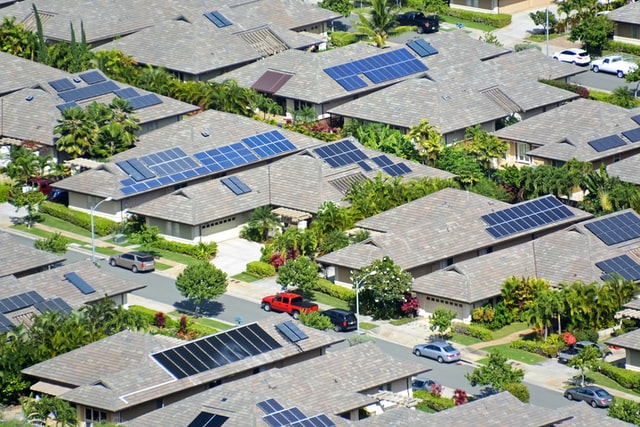
Being green is hot. Living sustainably and avoiding energy waste is the name of the game. Fortunately for us, we don't have to break the bank to be kind to the environment.
We need to align our remodeling budgets with current trends. From the looks of it, going green will be popular for a while. So let's review the energy-efficient real estate upgrades that will ultimately pay for themselves.
1. Take your lighting to the next level with smart bulbs
Over the last decade, LED bulbs have dominated the lighting industry. Halogens and fluorescents are phasing out with each passing year. LED bulbs have since come a long way.
Smart lighting is the industry jargon for bulbs we can turn on or off with Bluetooth or voice control. Bulbs sync together and connect to wireless networks. We can use apps to toggle lights remotely. Smart lights also allow us to schedule lighting for certain times of the day or days of the week. We can also change the colors and dim the lights.
Feature-rich LEDs save at least as much energy as their less intelligent predecessors. Homeowners save money on power bills by making it easier to turn lights off. Smart bulbs are slowly making physical light switches obsolete.
In addition, smart lighting appeals to homebuyers
Find Homes
2. Install programmable thermostats
Just set it, and forget it! Of course, we're not cooking rotisserie chicken, but we can make it easy to ensure perfect temperatures [at home] every time.
Smart thermostats allow residents to connect to their HVAC systems remotely with an app through a device like a smartphone or a tablet. We can schedule heating and cooling to occur when we're home and turn it off while we're away to prevent wasting energy on climate control when nobody is home. Some folks use different nighttime settings to save as much as possible.

3. Upgrade outdated water heaters
One could say we've had a flood of innovation over the past decade. There is no exception to water heaters. Conveniently enough, they say you should replace water heaters every ten years.
Tank models use more energy than tankless designs because they reheat water that cools in the tank. Tankless water heaters are more efficient because they only heat the water we use. Tankless heaters also last longer than tank models.
Electric heat pump water heaters are increasingly popular choices. They're environmentally friendly because they lack combustion. We can also program them to use grid power to heat water when energy rates are lower, saving money on utility bills.
Some states offer incentives for installing electric heat pump water heaters, making the cost of entry that much more affordable.
What Is Your Home Worth?
4. Replace appliances with an efficient version
Old appliances turn potential homebuyers off. They typically use more power to do the same job as newer alternative options. If it's old and taupe, just say nope.
New devices with the ENERGY STAR® sticker are more efficient than competing products. They're rated for the same performance standards as competing products but use less power.
Upgrading appliances with efficient machines gives sellers a talking point buyers want to hear.
5. Insulate and repair the roof
The roof transfers a lot of heat in and out of the home. In the summer, the roof is a heat shield that keeps hot air outside where it belongs. In the winter, the roof is a warm hat that keeps hot air inside where you want it to stay. We can improve our HVAC efficiency by increasing the amount of insulation in the roof.
Of course, we'll have to fix any leaks that might dampen our efforts. We don't want our insulation getting soaked, or it won't work as intended and could lead to more significant problems. If the roof isn't in peak performance, adding insulation will have a limited impact.
We still need to maintain the roof, even if there isn't a leak. If roof shingles are old, they'll stop working as designed. Some roofing materials don't insulate very well as they age.
Roof repair costs can vary. We'll want to shop around for the best deal. Working with contractors who use roofing software to create estimates will save us time finding the right person for the job. Buyers love seeing new roofs, and big-ticket items like this can be a deal-breaker.
6. Install solar panels
Solar panels are becoming stylish hats for the roofs of houses. They're fantastic additions because they save money on utility bills while making a statement about using less grid energy at the same time. While some people deck out their entire roof, it only takes a few panels to add some flare to your property.
Outside of the energy savings, federal and state incentive programs help offset the installation cost of renewable energy.

7. Juice up the amenities with home batteries
The sun isn't always out when we need to use the power. We lose the solar energy captured during the day when we don't store the power we cannot use. If you have solar panels, the logical next step is to pair them with batteries. The more energy we capture and save, the faster we get our money back from the initial investments.
We can benefit from home batteries with or without solar panels. Energy rates usually fluctuate based on demand. Home batteries are programmable to supplement power to the house when grid energy is more expensive during peak usage times and recharge when rates are more affordable. Besides saving on energy, the ability to power the house during an outage is among the best features home batteries offer.
Sell Your Home
Final thoughts
Of course, everybody loves to save money, but younger people have the most appreciation for energy efficiency. Millennials and zoomers are more concerned with climate change than are previous generations. We need to consider their interests because they account for the largest cohort of homebuyers. Likewise, renters of the same generations will look at smart upgrades as brag-worthy amenities.
Longer-term investors will get the most bang for their buck with energy-efficient upgrades. Incentive programs commonly offset the installation costs for green upgrades, but these improvements usually take several years to pay for themselves.
Conclusion
The general idea is to reduce consumption and make the most of our energy. Improving insulation, using more efficient appliances, and opting for renewable energy sources are upgrades with high demand that will eventually pay for themselves. We can make strategic remodeling decisions to get the most mileage out of our power consumption. With a trend as mainstream as going green, we'll lock in demand for the years to come.
This is an article written by Ryan Mahoney. He is a content publisher with a degree in sociology who enjoys writing about generational trends, technology, energy-efficiency, and design.
Images used:
Image 1: https://unsplash.com/photos/TBHOuN6URGU
Image 2: https://unsplash.com/photos/YO5q_7BN7kQ
Image 3: https://unsplash.com/photos/k8HniqcdYS4